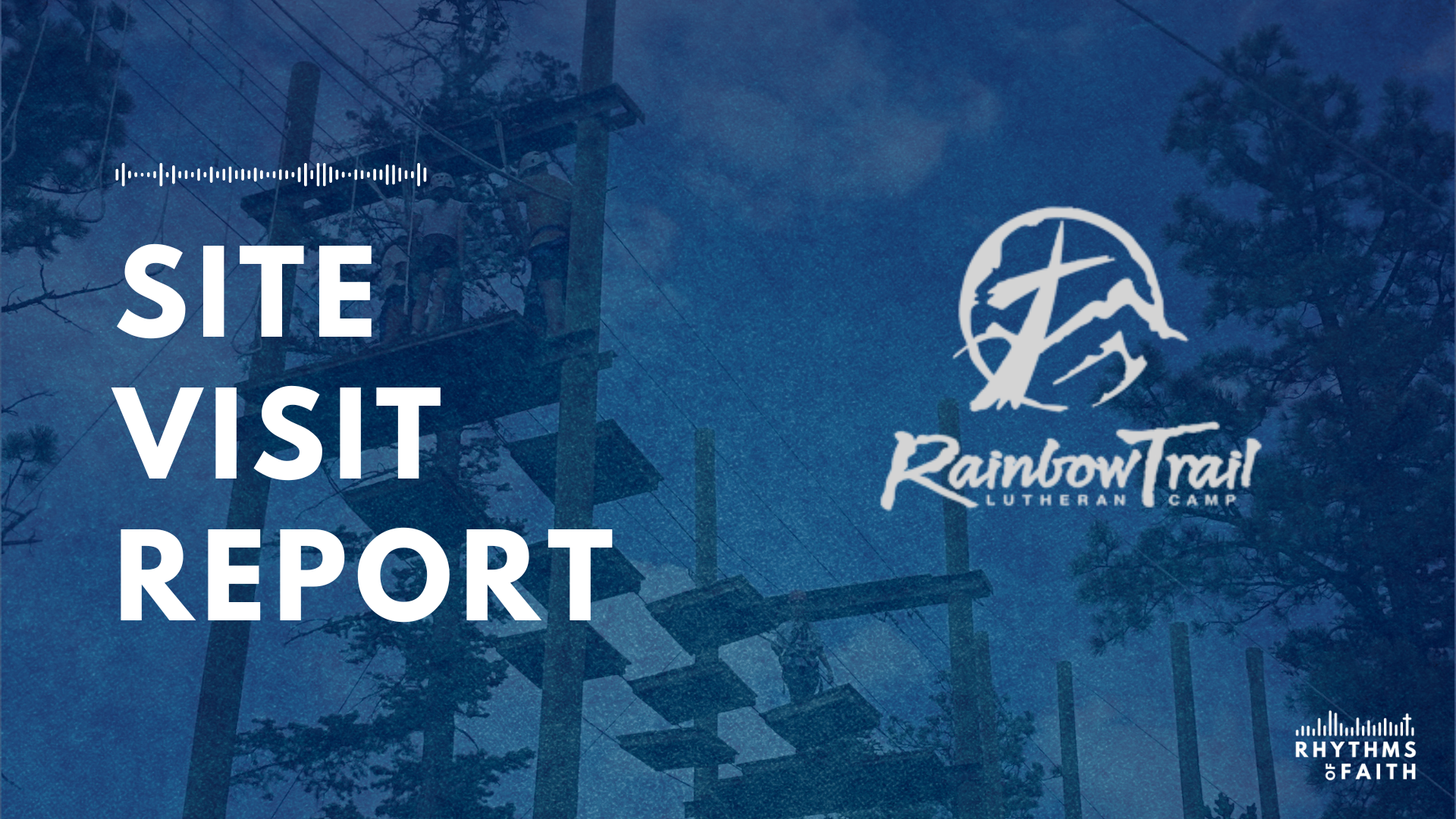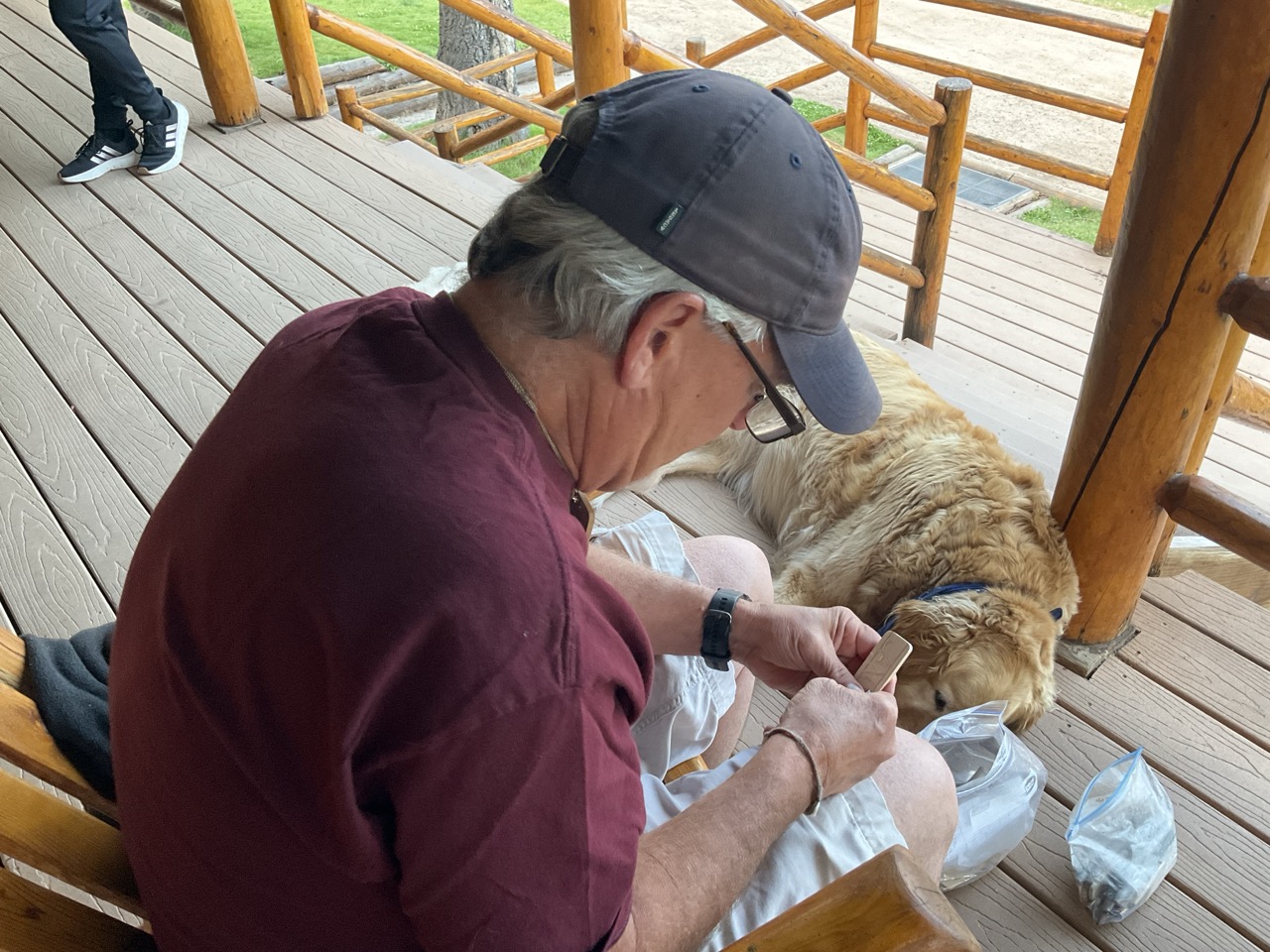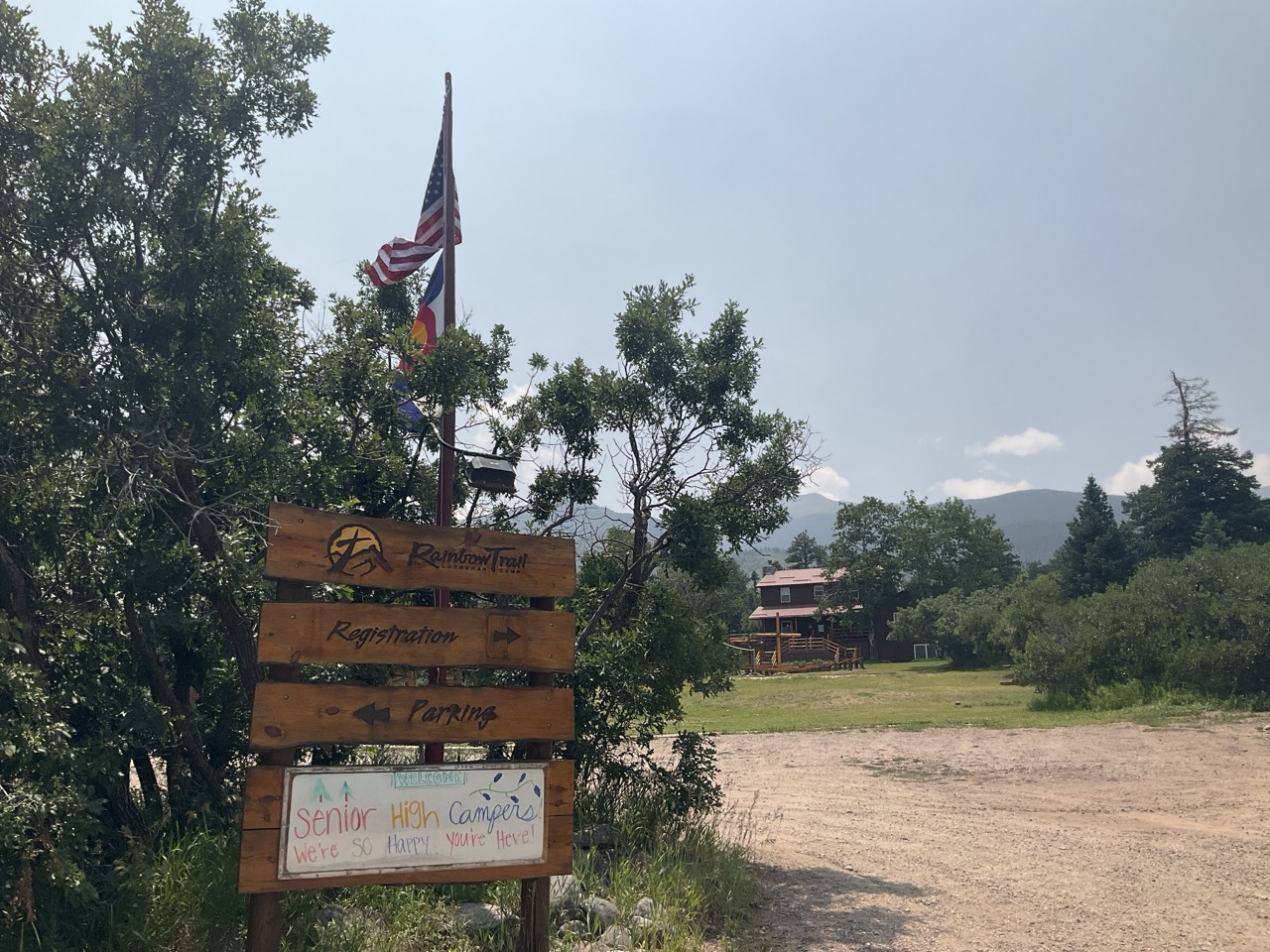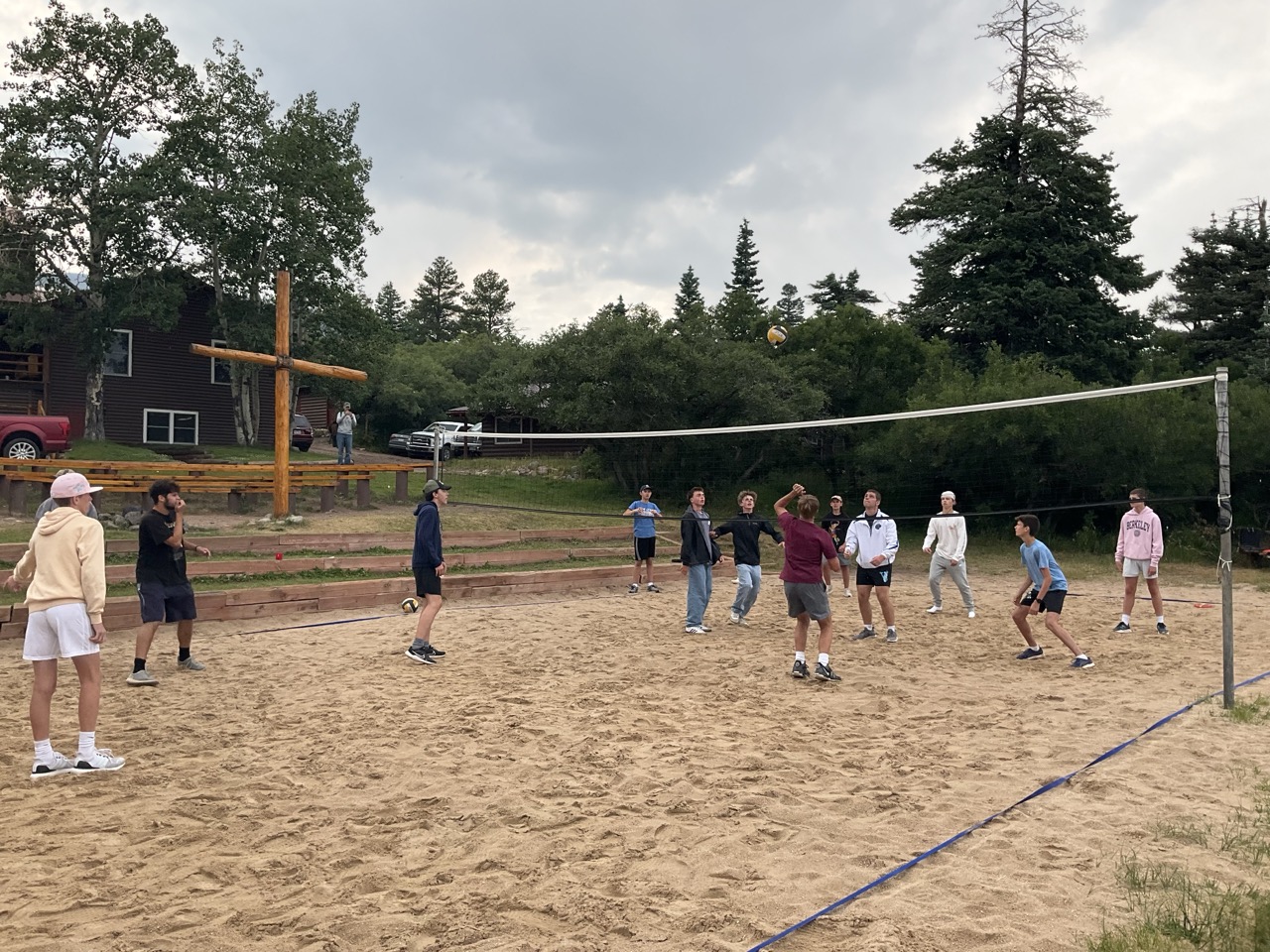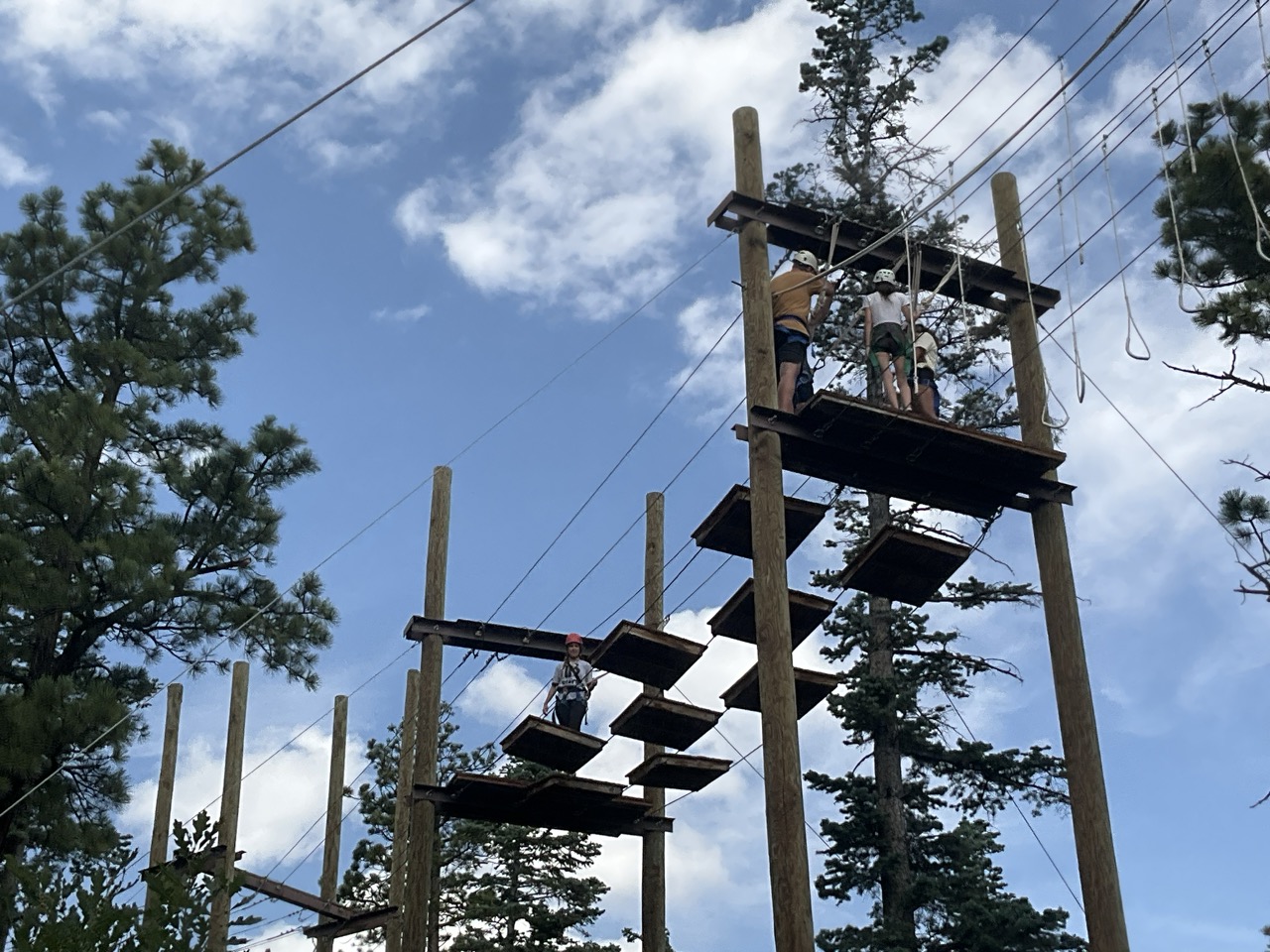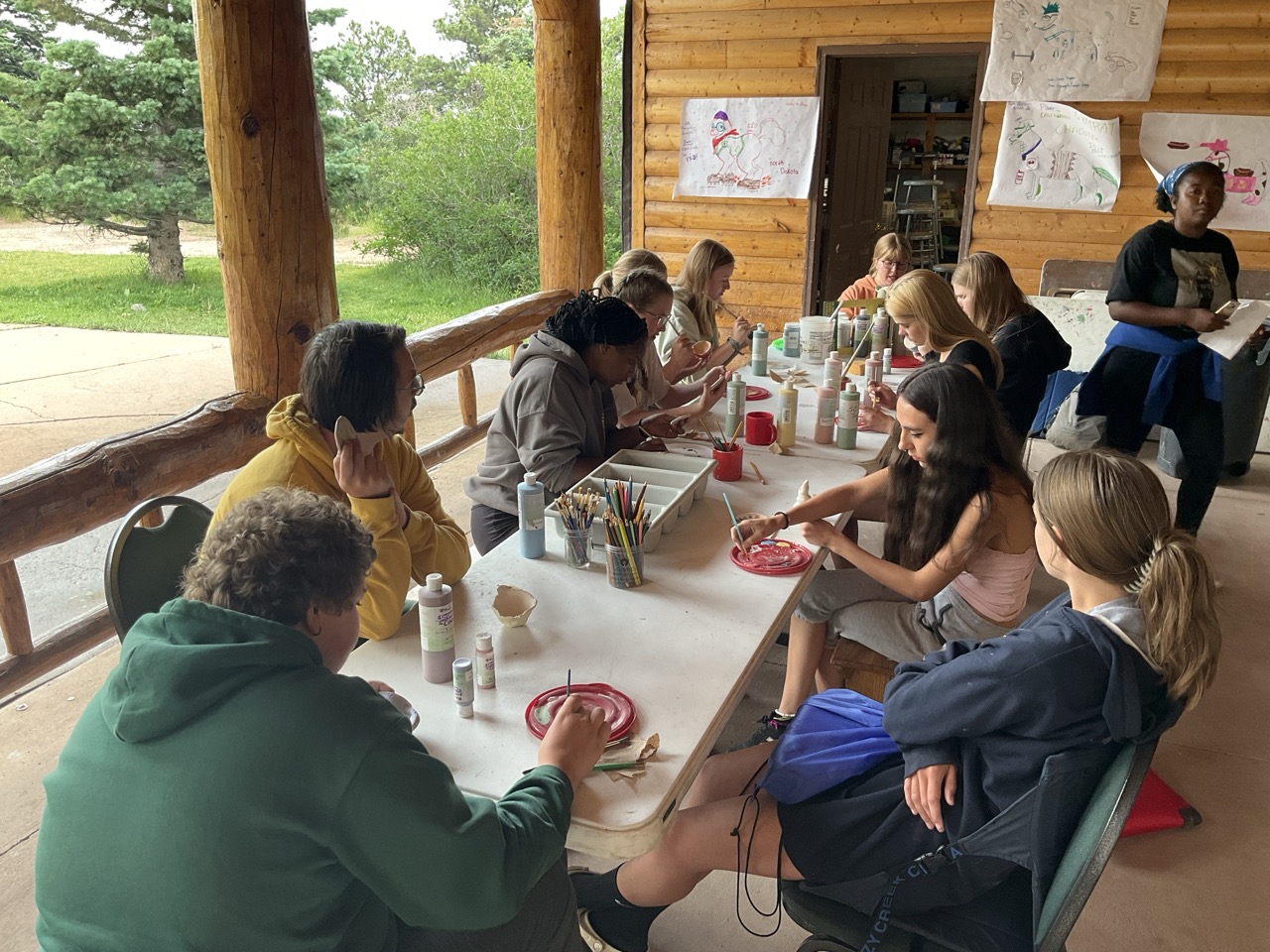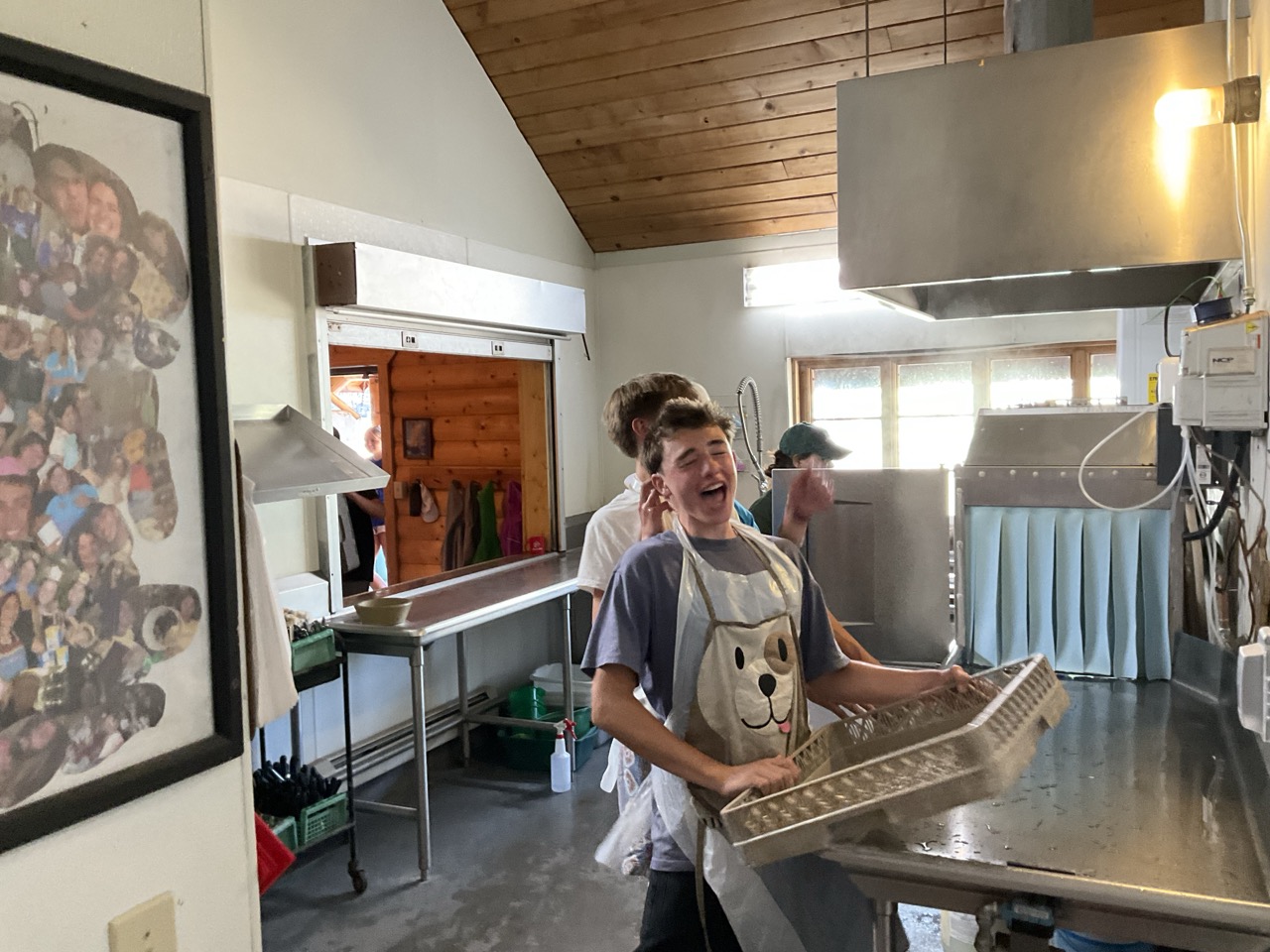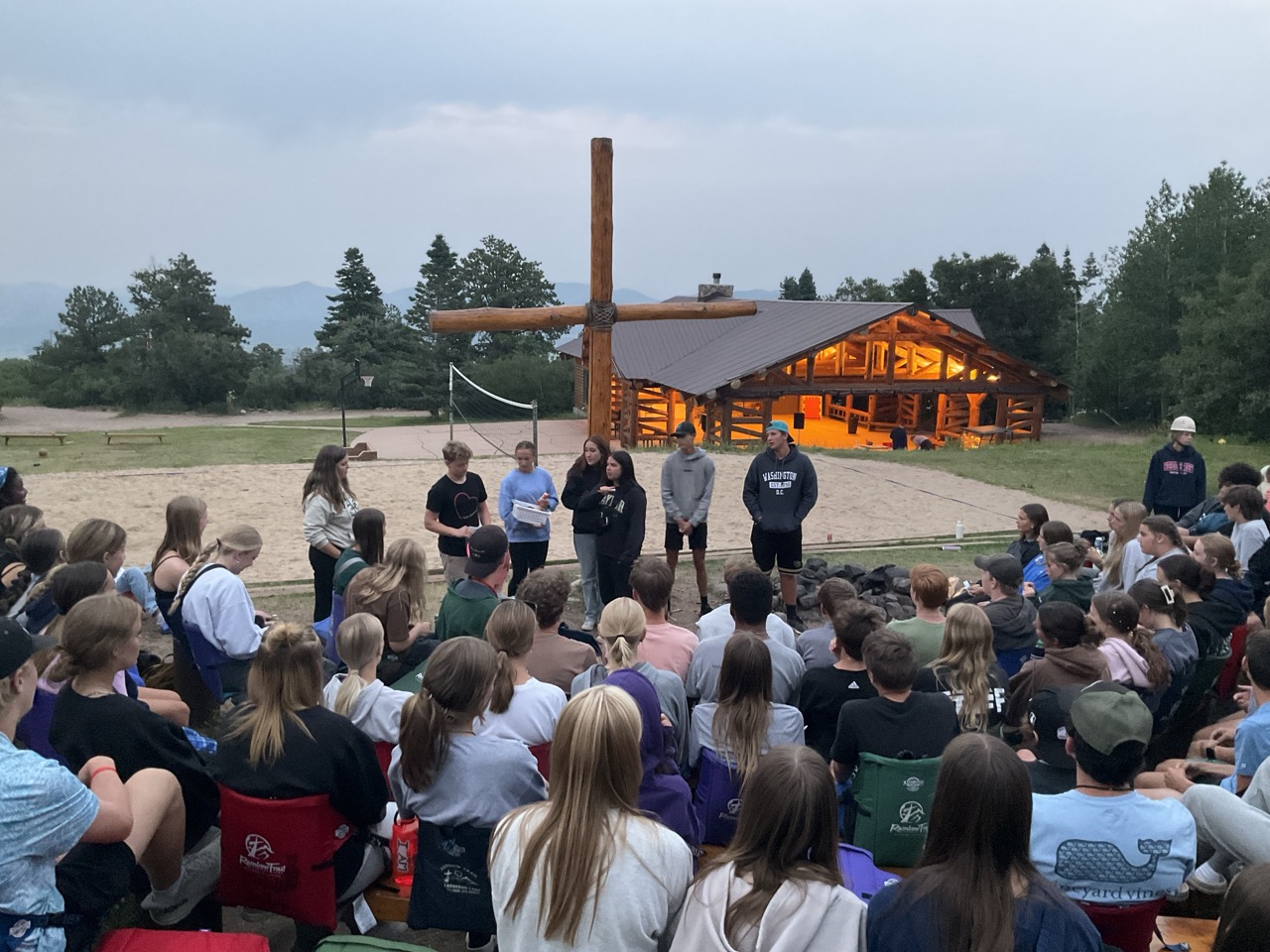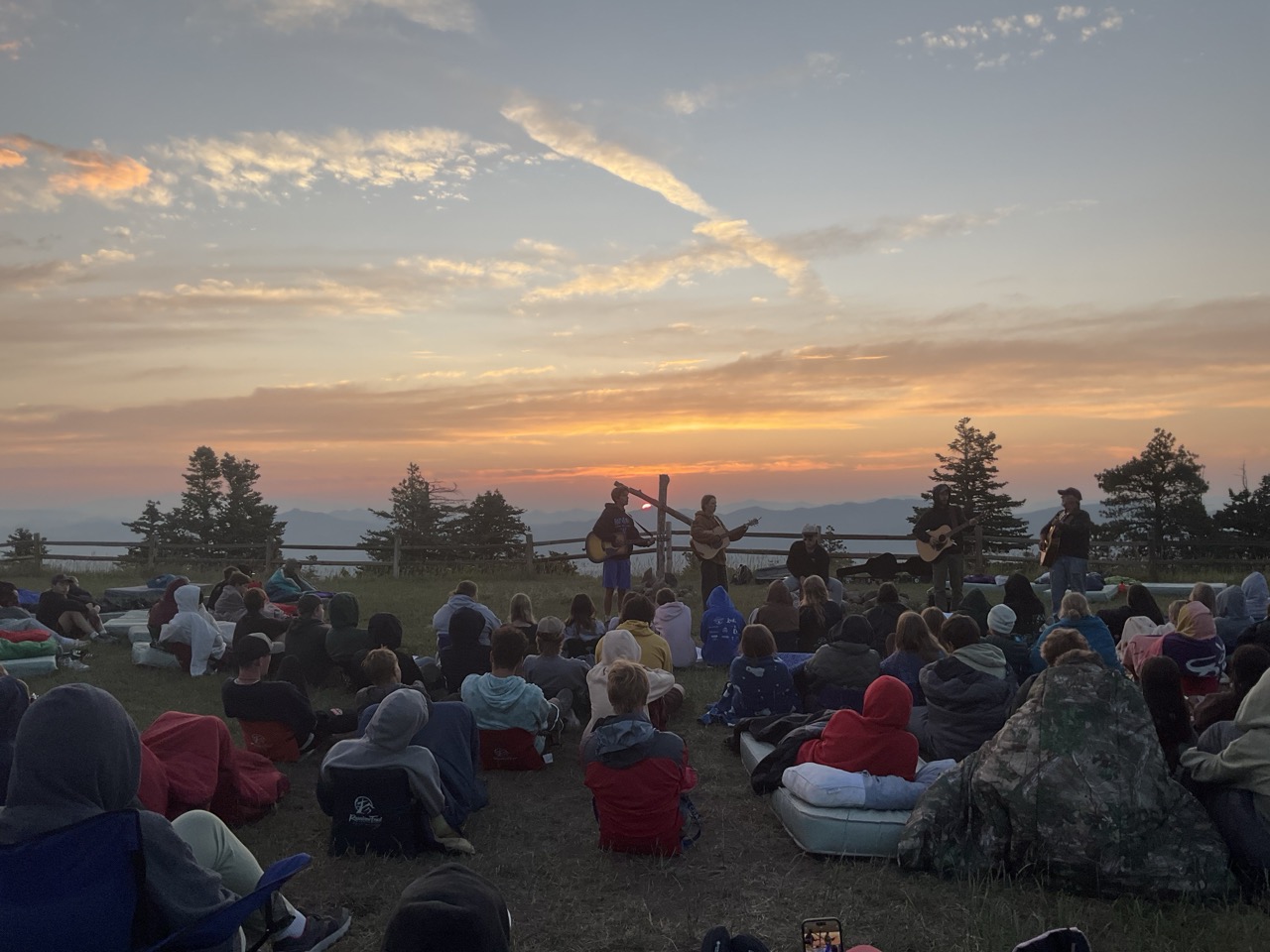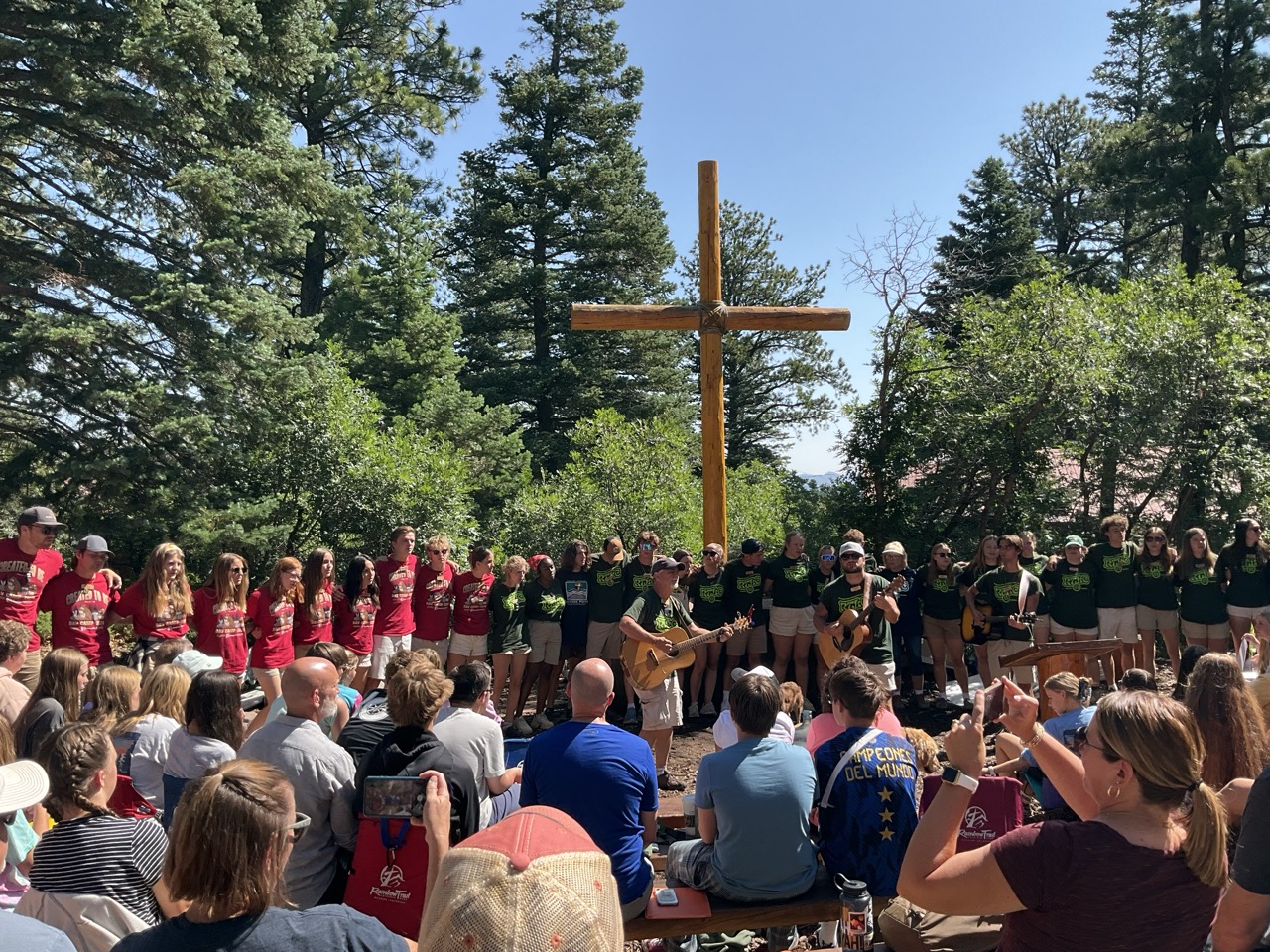“Is it done yet?”
The 5-year-old peered hopefully over the camp director’s shoulder, watching as his name appeared on the small piece of bass wood. “Almost, buddy,” the director replied with a smile. “Just don’t lose this one, okay?” He carefully carved the name into the wood and sprayed it with 3 coats of sealant (with drying time between each coat) before outlining the name in black and attaching a fastener. He explained as he worked that carving each nametag was an opportunity to pray intentionally for each staff member, volunteer, church leader, and family camper before they arrived. He made each one personally. I looked down at my own, tracing the etching with my finger, and marveled at the care it took to create each one. It was the first thing I received when I arrived at Rainbow Trail Lutheran Camp, and it was a tangible reminder (both to me and to others who saw me) that I was welcome here, that I belonged.
Dave Jarvis has been the director at Rainbow Trail for 36 years. With hundreds of adult guests and summer staff each summer, I quickly realized that he had carved somewhere north of 10,000 nametags over his tenure. That’s a lot of prayers.
As I sat in a circle with a group of summer staff later that week, I asked them what made Rainbow Trail special. “Dave,” one of them said simply. But that was only part of the answer. Another elaborated. “Intentionality,” she said. “Everything here has a purpose and there’s a reason for it and it’s important. And we’re important, too.”
This was a place of empowerment. Every experience was carefully curated to help campers, staff, and guests discover their God-given gifts, live into their identity as children of God, and equip them to take new skills and understandings into the world. Dave likened this to a toolbox, and each new experience at camp helped participants add new tools for service in the world.
A Set Apart Space
I traveled to Rainbow Trail as part of the Rhythms of Faith Project, which is investigating camp’s role as a catalyst for family faith formation. The camp is located in south-central Colorado, two hours southwest of Colorado Springs, in the Sangre de Cristo Mountains. From its perch at 8,500 feet elevation, participants can see Pike’s Peak looming 50 miles away. It is one of two camps in the Rocky Mountain Synod of the Evangelical Lutheran Church in America (ELCA), which means it draws participants from churches in a wide geographical area, from Texas and Kansas to Wyoming and Utah. Many campers travel to camp with their church group, while others sign up individually.
I arrived on a Tuesday afternoon, when all the campers were away on day hikes to a variety of locations near the property. These ranged in strenuousness from relatively short and flat hikes to an ascent of the nearby Eagle Peak, which looms above camp at 13,205 feet. The day hike was one of two adventure excursions that saw the campers leave the compact, 17-acre site that the camp leases from the forest service. The other was a river rafting trip later in the week.
The property was arranged in a series of roughly concentric circles, centered on a large field where campers played games, ate lunch, and gathered in between activities. Surrounding the field was the ring of principal community buildings: Columbine (housing the main office and welcome center), the dining hall, the shower house, and the building housing the camp store. The next ring consisted of camper cabins and program areas. The cabins were arranged in a long meandering line just past the shower house and neatly tucked away among the trees for privacy. They were semi-rustic, with electricity and comfortable bunks but not indoor plumbing. Down the hill from the center of camp was the large open-air pavilion, which served as another center of group activity, along with always-busy sports areas for basketball, sand volleyball, and tetherball. The outer ring of the property had farther-flung activity and ministry areas, including an archery range, high ropes course, flat playing field, labyrinth, and additional campfire/worship areas. Rocky trails crisscrossed the camp, and towering conifers embraced the property, along with scattered oak, aspen, and other hardwoods.
There were 105 high school campers during the week of my visit, which staff described as a nice, full week. This was one of two weeks reserved for high school campers, with most other weeks seeing a combination of elementary and junior high ages. Additional sessions were reserved for specialty programs like confirmation camp and family camp. The campers stayed in cabin groups of 6-8, along with a college-age counselor, and cabins were grouped together into 5 “villages.” This village system offered an innovative decentralized element to an otherwise centralized program that featured daily all-camp activities, large-group worships, and most meals in a boisterous dining hall. The campers spent most of the time with their village, which generally consisted of 3 cabin groups. This provided a trusted, small-group community within the larger camp community.
Programming for Agency
“Good problem solving. Thank you for your flexibility.”
We were gathered in a circle with a group of campers, staff members, and adult volunteers on the deck of the welcome center. We were there to establish the schedule for the day and check in about community concerns. There was a camper representative from each village to advocate for their village’s preferences for activities and schedule.
They were accompanied by a counselor, who offered support and encouragement through the process but otherwise let the campers lead. They took turns proposing an activity at a specific time and checking with program specialists about availability. When there were conflicts, such as two villages proposing wood carving at the same time, they worked it out and compromised.
The sticking point this morning came when one village challenged another to a game of capture the flag on the ball field that afternoon. Unfortunately, that village was committed to high ropes at the same time, and they were having difficulty rearranging their schedule. After a few minutes of discussion, the representative from a third village announced that they would be willing to move their pottery time, with approval from the pottery specialist, to free up space in their schedule to accommodate a game of capture the flag. The original village representative assented to this compromise, and the entire circle smiled as they proclaimed in practiced unison, “Challenge…accepted!”
By the end of the meeting, each village representative and adult volunteer had a printed schedule of the day’s activities and locations. They repeated this process every day, meaning that over the course of the week, roughly a quarter of all campers got the chance to represent their village at the morning meeting. I found it a beautiful example of democratic decision-making and camper empowerment. But it was only one of many examples.
Campers were engaged in planning and leading nearly every aspect of the camp experience. Each day, 3 of the 5 villages had special tasks. One village was assigned to clean the shower house (or “ShoHo”), which they did during the morning meeting. Another was assigned to KP for the day, which meant helping in the dining hall before and after each meal. These were far from menial tasks at Rainbow Trail. In fact, the campers and staff described them as fun. One said, “Where are you going to go where doing dishes is fun? Or cleaning a toilet? But it’s fun here.” In fact, they modified the meaning of KP from its military usage to stand for “kitchen party.” I must admit, it lived up to the name. I walked into the dining hall during one kitchen party and saw the campers dancing as they mopped, singing as they did dishes, and enjoying a rousing game of dish rack bowling (exactly what it sounds like). The village on KP was also in charge of choosing the mealtime prayers from a long repertoire of graces sung to popular tunes. After singing grace, a representative from the village would then lead the camp community in a spoken prayer of thanksgiving.
The third village assignment was the most involved. This was the Village of the Day (VOD). They established a fun theme for the day and decorated the dining hall accordingly. This theme was always creatively connected to the Bible study. For example, Thursday’s Bible study was “Created to be a disciple,” and the V.O.D. established a theme based on the Minions movie series (complete with face paint!). They connected the silly pop culture image of the Minions following their leader Gru to the focus of discipleship as following Jesus.
The V.O.D. also planned and led the two daily worship services, which included selecting songs, leading the prayers and liturgical pieces (e.g. the benediction), inviting someone to offer a message or testimony, and preparing a location. On top of these tasks, the V.O.D. also planned and led an evening activity for the entire camp. This was oftentimes based on their theme. The tasks of this village were so involved that they would block out hours in their schedule to plan for them.
With 5 full days of programming (Monday-Friday), each village had the chance to be V.O.D., ShoHo, and KP. This meant that campers were always leading and always contributing to the life of the community through service. This agency encouraged them to learn by doing, and the specific lessons of each day were reinforced through participatory learning, individual reflection, and group reflection. There was a set-aside hour for Bible study each day, during which small groups dove deeply into the scripture and daily theme with discussion and activities. Morning and evening worship bracketed the day and reinforced the Bible study theme. Each morning, the campers had a time dedicated to individual devotions called “Morning Watch.” They spread out and used a printed devotional resource that guided them through scripture, questions to ponder, and prayer. Each evening after dinner, there was a time called “Round Up,” when each village creatively presented some takeaways from Bible study that day, allowing them to put it in their own words and teach their fellow campers. Through all this learning and reflection, they had the guidance and support of their counselors, along with a host of other adults.
Intergenerational Support
“There’s been a mistake. You actually do have enough money in your account.”
We were at the camp store (“Pop Shop”), and a camper was hoping to purchase a Crazy Creek chair. These were super useful at Rainbow Trail, since most of the activities were outside, and only a few locations had seating areas, which meant a lot of time sitting on the rocky ground. Most campers (and all the adults, it appeared) had special camp chairs that were portable and had comfortable back support. This camper did not have enough money in their account. That is, until one of the camp grandparents slipped some cash to the cashier and instructed them to simply tell the camper that there was an accounting error. The mildly confused camper smiled and completed the purchase, unaware of the slightly shady source of their good fortune.
I was one of 20 visiting adults at camp, and we were all sporting personalized nametags. Several were pastors and youth leaders from churches that brought groups to camp, including some from Texas and eastern Kansas, as well as others from much closer churches in Colorado. Seven of the adults on camp had the special title of “camp grandparents,” and this honorary title was even included on their nametags. They were on site specifically to offer an intergenerational ministry perspective. They participated in Bible studies and were present for campers and staff members, providing another person to talk with. Some were retired school professionals, and others were caring adults with long histories with the camp. They applied to be part of the program, and many came year after year because they found it so meaningful. Some of the campers really connected with these folks, sharing some of their personal struggles and challenges. That is how the accounting error came about. The camp grandparent knew the camper’s story, and specifically that this camper came from a disadvantaged home. They wanted to cover the cost without drawing attention to the camper’s home life, so they simply slipped the cashier a twenty. Typical grandparent shenanigans, I thought with a laugh.
I got to know many of the campers’ stories during my time at camp, as ministry took precedent over research. One camper was being cared for by social services and was at camp under a special scholarship program, accompanied by a case worker (a caring adult who got to know the other campers so well that they were invited to give the message at worship when the group was V.O.D.). Another camper was in the process of transitioning genders. Several others were neurodivergent and struggled with certain activities or social environments. All of them found belonging and welcome at Rainbow Trail.
Their stories became inspiration to others, their words and actions ministry to their fellow campers and supporting adults. As one of the adults reflected, “This is one of the places where kids can just be themselves…And they are accepted for exactly who they are supposed to be, and they don’t have to be anybody else. That gives them confidence and it gives them strength in their faith.”
Partnership with Churches
“I believe that camp should be priority number one for the church…Because of the community and because of the focus on God, it has an impact like nothing else.”
I was sitting with a group of church leaders for a focus group, and they took turns sharing about the deep partnership that Rainbow Trail has cultivated with their congregations. This particular pastor served at a Lutheran church that had left the ELCA more than a decade before to join the more theologically conservative North American Lutheran Church (NALC). But they wanted to maintain their connection to Rainbow Trail, and this pastor still found welcome in the community, despite the official church ties being severed. I learned that these longstanding partnerships were very common, and the church leaders described lasting impacts on their congregations.
One church leader was new to her role as youth minister, so this was her first time coming to Rainbow Trail, though the congregation had been connected for years. “Now I understand where it comes from,” she told me. She was referring to the leadership and ministry skills of the young people in her congregation. She had just completed a week of Vacation Bible School (VBS) at her congregation, which engaged more than 300 kids. She told me how impressed she was by the engagement and initiative of the middle and high school youth volunteers. They led songs, skits, and mealtime prayers. They stepped in to help without being asked. This week at Rainbow Trail, she saw where all these skills originated, recognizing the songs and prayers that her youth had taught her and witnessing camp’s commitment to nurturing skills for leadership and service. Other church leaders agreed, sharing stories of how young people returned from camp more able and willing to participate in church leadership and volunteer for church ministries. One pastor described how she incorporated “camp-style decision making” and “camp-style worship elements” into the life and worship of her congregation. Another explained that youth were willing to share personal testimonies to the church community after experiencing camp.
The intentional partnership was also clear in the programs designed especially for churches, such as confirmation camp and traveling day camp. Rainbow Trail sets aside two weeks each summer for groups of confirmation students, who come to camp accompanied by church leaders as part of their confirmation instruction. Traveling day camp is a program in which teams of 4 or more summer staff are deployed to partner churches to lead week-long day camp programs for elementary aged children. Rainbow Trail deploys 4 of these teams each week, directly serving a total of 30 church day camps. The leadership of these day camps are frequently supplemented by youth members of the congregation who had camp experiences that prepped them for leadership.
Even their Bible study theme intentionally connected them to the wider church. They adopted the same theme (Created to Be) as the ELCA used for their national youth gathering, which welcomed more than 17,000 high school youth to a convention in New Orleans. I was at camp the week immediately following this ELCA Gathering, and there were several church leaders and campers who had just been to this event days before.
Experiencing the Real World
“The Lord make his face shine down upon you. The sun rise up to meet you on your way. The Spirit of God’s love invade the circle of your friends, God’s vision keep you changin’ day by day.”
There were tears and smiles in the mixed crowd of campers, adult leaders, and parents, as the staff sang the song that was familiar to so many of them. It was closing worship on Saturday morning. Another week had come to an end. Most of the campers had heard this sending song multiple times before in their previous camp experiences, and many of their parents had also experienced this as campers or staff members. The staff also sang it the night before, as they gave honorary staff shirts to me and the 19 other visiting adults. A group of staff also sang it before dawn that morning for the church group from central Texas that had to leave by 6:00 AM in order to get home at a reasonable time. Everyone got a proper sending, even individual campers who had to leave partway through the week.
Parents joined in the closing worship service, as campers and staff sang their favorite camp songs and walked through what they learned in Bible study. Dave addressed the parents, thanking them for trusting camp with their children and reminding them of the parent devotional they had received in the mail. He encouraged them to walk through it with their children in the coming week. He also addressed the campers: “I saw the real you here. Will that real you go home with you?”
It was an open question and one that the campers had struggled to answer during my focus groups with them. They loved camp. They wanted to keep coming back year after year, and several indicated a desire to serve on camp staff. They felt like their faith came alive here in ways that were difficult in other spaces. There was clear evidence from the observations of church leaders and parents that faith and leadership skills developed at camp continued to bear fruit in the weeks and months after camp. But the campers struggled to imagine how they could experience something like camp in any other space.
“The kids call it the ‘real world,’” one mother told me in our parent focus group. “They get to unplug from this digital world that they don’t really believe is real and they come here and experience life outside of phones and communication. Real relationships. Everything else is just not as real as it should be.” The parents gushed with passion and appreciation for Rainbow Trail. Many of them had been youth campers, came to family camp, or even served on summer staff, and they loved having this shared experience with their children.
Along with new memories and skills, the campers went home with the devotion book they used during morning God time and a small memento. It was a key chain that they were encouraged to put on their backpack, water bottle, or other item they used daily as a physical reminder of their camp experience. In addition to the Bible study theme and verse (Psalm 139:13-14), it had a short admonition that was often repeated at Rainbow Trail: “Don’t go make a difference in the world. Go make the world different.”
As I prepared to head down the mountain, I passed Dave on the deck of the welcome center. He had a stack of bass wood and a list of the adult volunteers who would be arriving at camp the next day. He prayerfully etched each name, preparing to welcome a new group of current church leaders to Rainbow Trail and empower a new generation of developing leaders.

